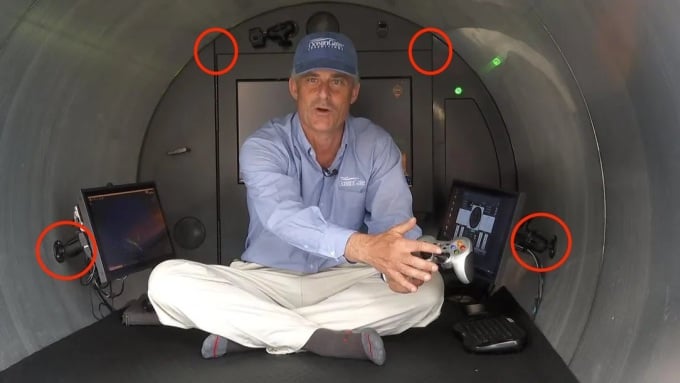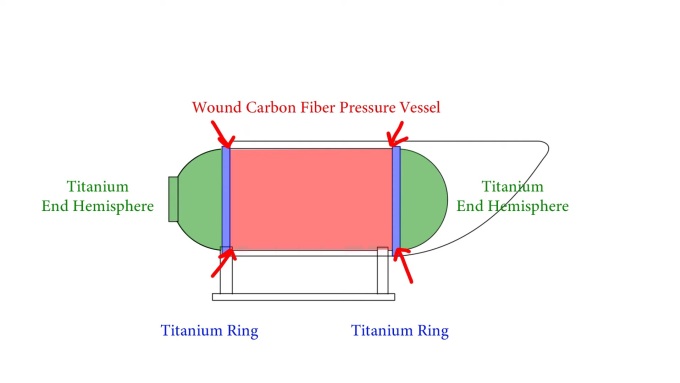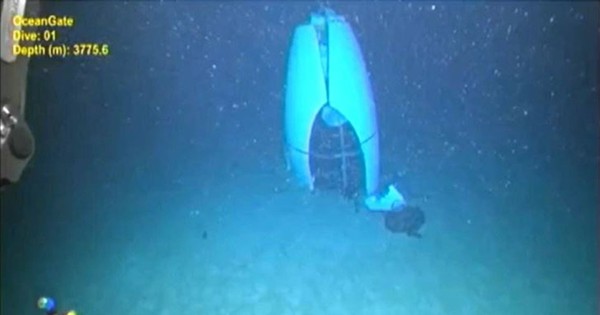The screws that secure the display to the Titan's hull could cause the carbon fiber shell to gradually weaken and be crushed under the sea when it reaches a threshold, experts say.
The tragedy of the Titan submersible being crushed at the bottom of the Atlantic Ocean on June 23rd has attracted the attention of both the media and experts. Besides the comments about the design errors, structural errors or diving too deep of the Titan, the hypothesis of failure due to materials (Materials Failure) has also been raised by experts.
There are reports that the manufacturer OceanGate has arbitrarily converted the Titan from a scientific remote sensing vessel to a passenger cruise ship. Images of the ship's construction released by OceanGate show that the company has bolted two display screens directly to the hull, which is covered in carbon fiber on the outside, as CEO Stockton Rush once advertised.

Two screens bolted to the hull and hand-jointed (above) in the Titan are shown in the Titan submersible introduction video. Photo: OceanGate
This is a taboo because carbon fiber is 5 times stronger than steel but very brittle, often mixed with resin glue to stick to the surface of the material to be covered. This coating process is created from layers on top of each other, similar to sticking layers of paper with glue.
The carbon fiber structure would therefore not be a pure monolithic sheet, but a composite of carbon fiber and resin. OceanGate used the name "carbon fiber composite" for this material in a patent granted in 2021.
Because it is a composite, there are microscopic voids in the carbon fiber structure that the resin cannot fill. OceanGate says the void ratio is less than 1%, but this number is not specified. The difference between a void ratio of 0.99% and 0.0000000000001% can have a huge impact on the overall structural framework as well as the material's rate of fracture.
The method of drilling and screwing the screen onto the hull would have created small cracks in the composite surface inside. After many dives to visit the Titanic wreck at a depth of 3,800 m, the Titan's hull was continuously under great pressure for a long time, causing cracks to spread as quickly as broken glass.
This phenomenon can be compared to the image of a glacier with a hole on its surface. The crack is initially small, but gradually, after each long enough hammering and with enough force, it will cause a block of hundreds of meters to split open, leading to a large block of ice cracking.
Carbon fiber is known for its strength, but it's not the compressive strength that's key to withstanding the pressure at the bottom of the ocean, but the tensile strength that keeps the frame from stretching and breaking.
Composite carbon fibers crack more slowly than pure carbon fibers, causing the cracking process to occur gradually, the structural cracks are too small to be detected from the outside. The rate of cracking within the same layer of carbon fiber will be faster from layer to layer, so the cracks will gradually grow, until the innermost structure is extremely weak.
When all conditions are met, just a slight collision, a sliding push with any object on the ocean floor, is enough to cause a terrible collapse of the Titan submersible, taking the lives of 5 people on board.
In that case, the carbon fiber composite structure would suddenly collapse, even though previous trips had been normal. This explains why Titan’s previous trips were normal, but the final trip on June 18 was when the spacecraft reached its breaking point.
Even if there is a certain gap between the titanium hull and the carbon fiber composite outer shell so that the screw holes do not cause cracks, drilling into the titanium hull of the ship also creates an opportunity for rust to occur more quickly on the metal.
Titanium is less susceptible to rust than iron and copper, but the color of the hull is not pure titanium, but more like a titanium alloy as OceanGate advertises, or a hard steel material similar to the US Navy's use for submarines.
The process of wrapping carbon fiber around the Titan's hull. Source: OceanGate
OceanGate could use an alloy instead of pure titanium to make the hull, cutting manufacturing costs, but also making it more susceptible to rust. In that case, the bolt locations would always be the first to rust, leading to the risk of spreading and weakening the surrounding structure.
OceanGate likely had additional screws added to its hull, as it was being converted to carry tourists and required extensive monitoring equipment. Additionally, the frame welds on the doors were quite rough, without any additional anti-rust or anti-corrosion coating, similar to the design of windows mounted on a home balcony.
In materials technology, the underside of the weld is the most susceptible to rust and structural deterioration due to the contact of at least two different materials.
The risk in this method is even higher than the bolting method. The weld may have a metallic bond that leads to rapid rust spread due to electrochemical corrosion when exposed to high humidity. To limit the risk, the manufacturer can cover these welds with a thin anti-abrasion, anti-corrosion film to protect the material and structure in environmental exposure conditions, but there is no evidence that OceanGate has implemented this safety measure.
The Titan submersible design from the original OceanGate patent shows that the vessel is based on the first generation Alvin DSV deep-sea submersible, which is still in use today. Instead of using the traditional spherical shape to optimize the ability to withstand pressure from all directions, Mr. Rush converted the Titan into a tube to accommodate more passengers.
The two ends of the jar on both sides are made of titanium, while the central cylindrical frame is wrapped with multiple layers of carbon fiber about 13 cm thick. The central cylinder block, according to this design, becomes the main load-bearing area, while this is the area that has been intervened with bolting and welding measures.

The design of the OceanGate submersible features two ends and a ring, which reinforces the connection point, made of titanium. Graphic: Oceanliner Designs
The 13-cm-thick carbon coating may help the ship increase its resistance to external pressure, but it also inadvertently increases its brittleness and makes it more difficult to observe very small cracks inside the layer structure.
The joints between the body and the titanium head and tail are not 3D printed from a single batch, but are welded together using a sealing mechanism, which creates the risk of weakening the mechanical frame. The overall structure is very weak due to the use of different materials such as carbon fiber, titanium and acrylic glass. Each material has different strength, expansion and brittleness in the same environment.
This is also the reason why 3D printing technology is preferred for manufacturing spacecraft hulls, although it is many times more expensive than the assembly method. With this technology, manufacturers only need to 3D print once to have a complete product, no matter how complex the design is, without any welding or bolting, which helps reduce the risk to the overall structure.
In its patent, OceanGate mentions that it has tested the Titan submersible safely at pressures of 5,000 - 6,000 psi (400 times atmospheric pressure). This test pressure is equivalent to the pressure the submersible would face at a depth of 4,000 meters.
But in terms of the safety assessment process, this is an extremely serious error. The manufacturer is responsible for ensuring that the product can withstand conditions many times harsher than those in regular use. OceanGate should have ensured that the Titan could withstand at least 8,000-10,000 psi of pressure before allowing it to operate regularly at 6,000 psi, instead of allowing it to carry tourists at the maximum level according to the test results.
OceanGate's marketing tactics for the Titan and its expedition cruise packages have also raised questions about whether safety inspections have been carried out to international standards.

Debris from the Titan submersible is brought to the port of Saint John, Canada, on June 28. Photo: AP
OceanGate has claimed that its submersible is so new that it exceeds conventional safety standards and cannot be inspected by any agency. On the other hand, OceanGate uses the unproven term “titanium alloy-carbon fiber” in its patent, instead of clearly defining the material as “titanium alloy” rather than pure titanium and carbon fiber composite rather than pure carbon fiber.
In fact, manufacturers can use new materials that are stronger, more durable, and harder, but they must always ensure safety standards above the minimum. Self-improvement and setting your own safety standards always pose a risk of causing accidents.
The article represents the views of author Dang Nhat Minh, currently a PhD candidate at the Australian Research Council Centre for Advanced Surface Engineering of Materials (ARC SEAM), based at Swinburne University of Technology in Melbourne.
Dang Nhat Minh
Source link





![[Photo] Closing of the 11th Conference of the 13th Central Committee of the Communist Party of Vietnam](https://vstatic.vietnam.vn/vietnam/resource/IMAGE/2025/4/12/114b57fe6e9b4814a5ddfacf6dfe5b7f)




























![[Photo] Overcoming all difficulties, speeding up construction progress of Hoa Binh Hydropower Plant Expansion Project](https://vstatic.vietnam.vn/vietnam/resource/IMAGE/2025/4/12/bff04b551e98484c84d74c8faa3526e0)































































Comment (0)